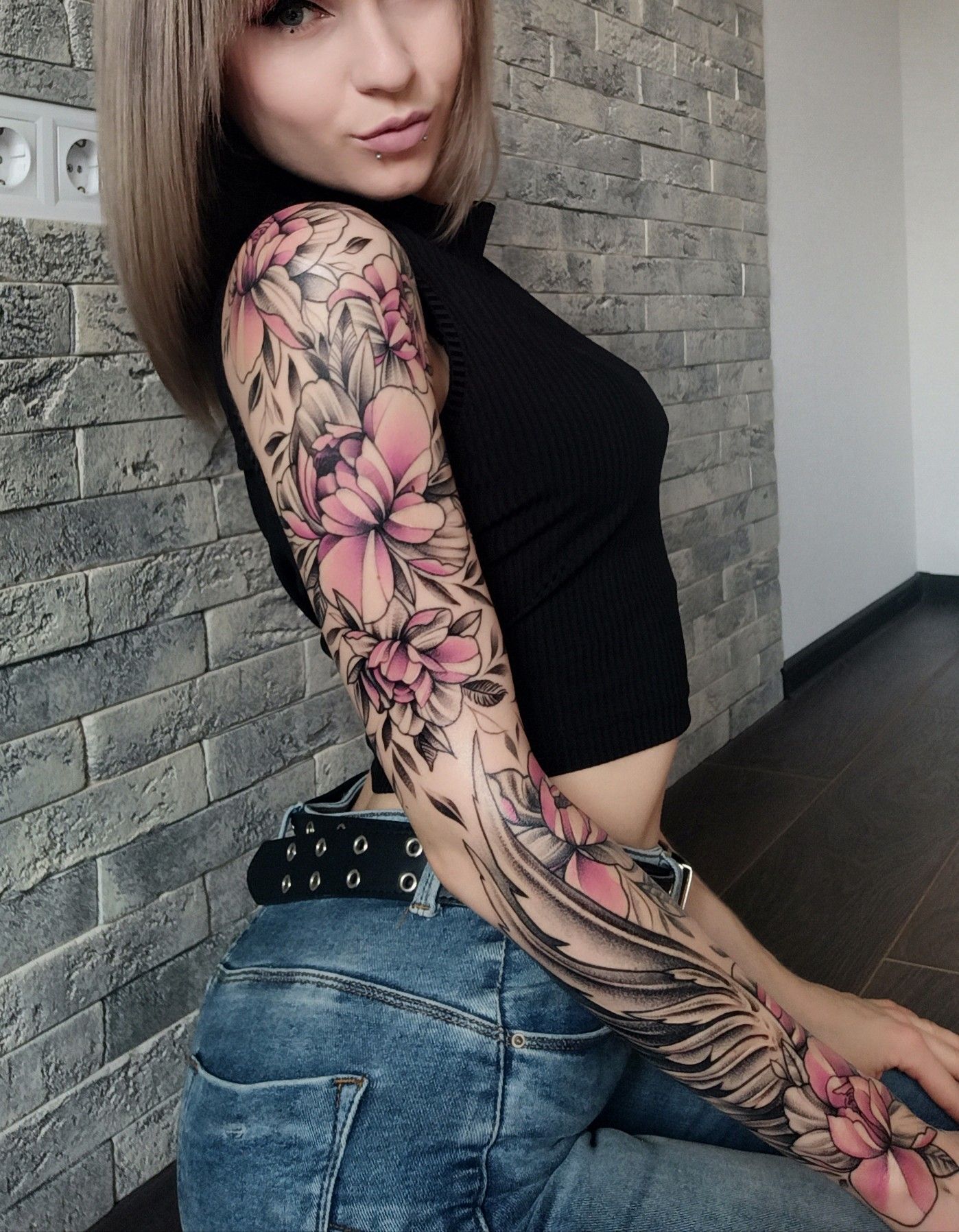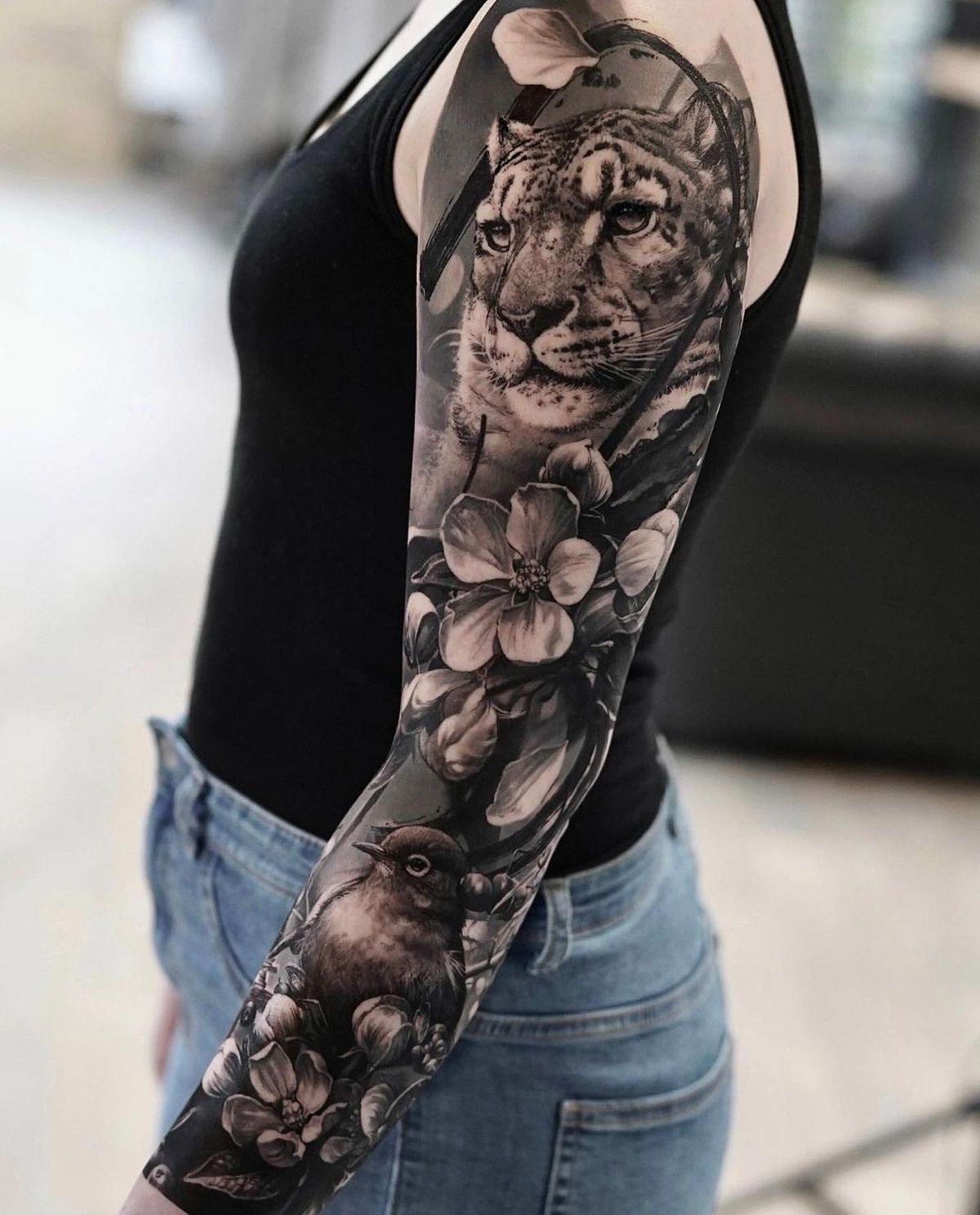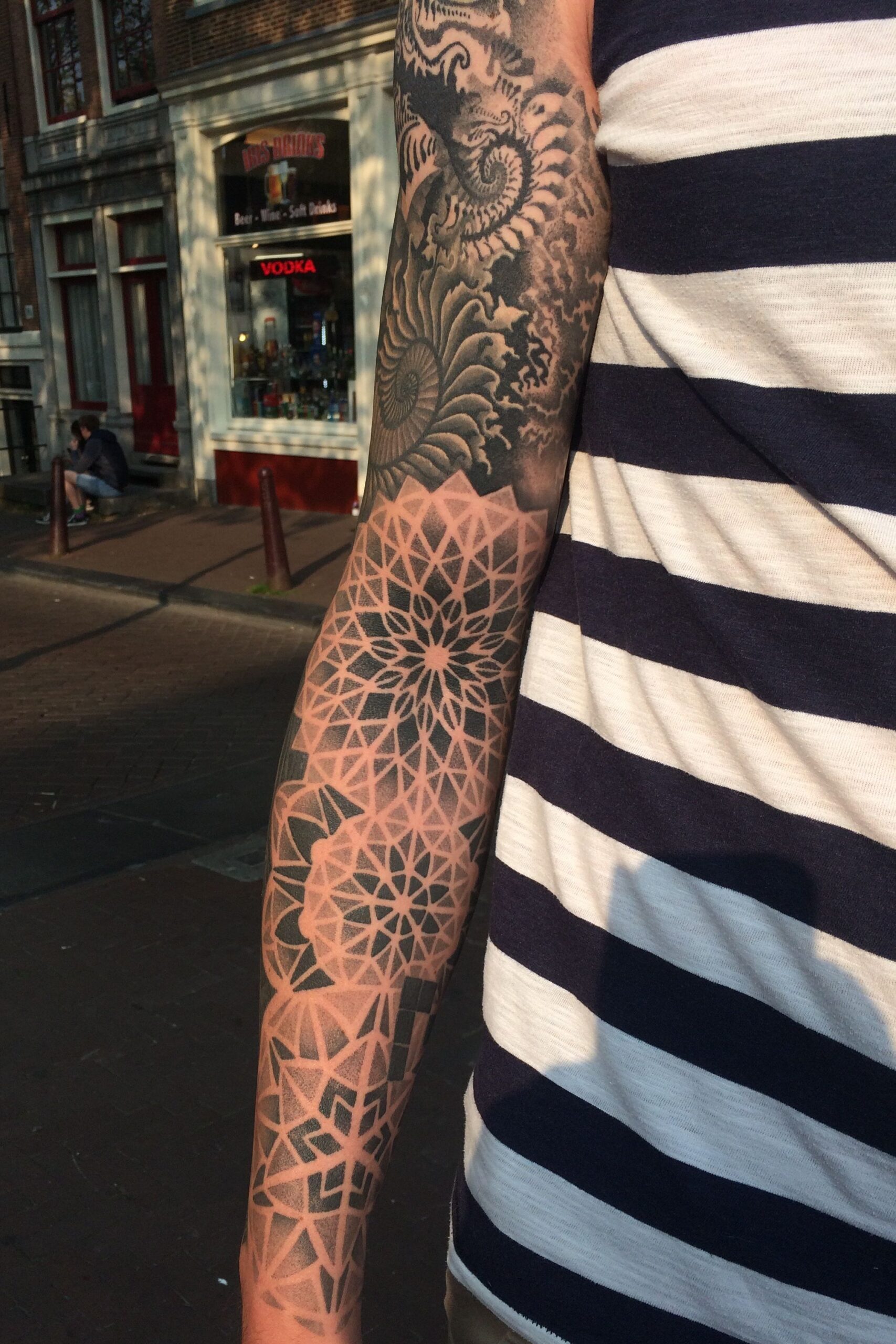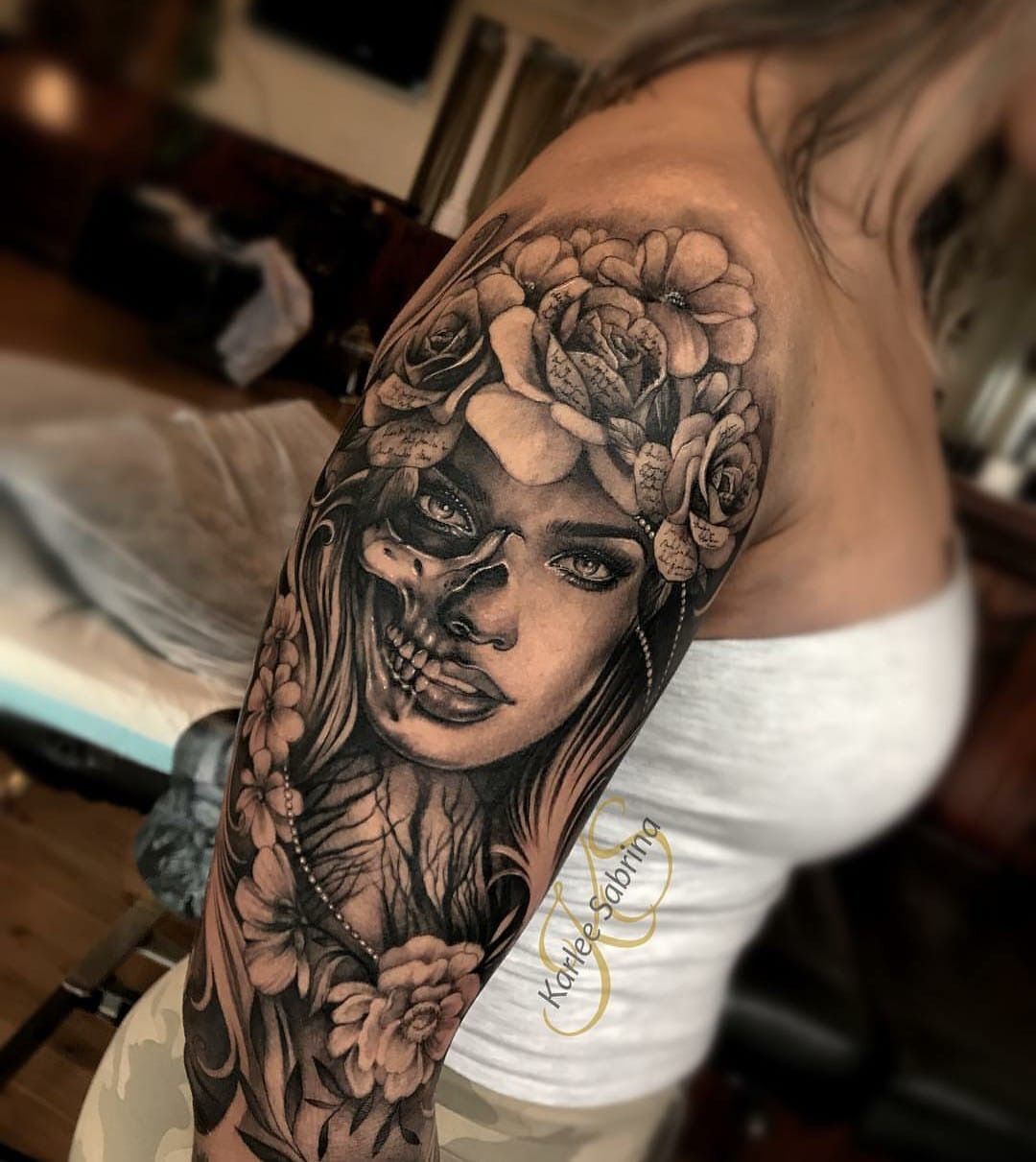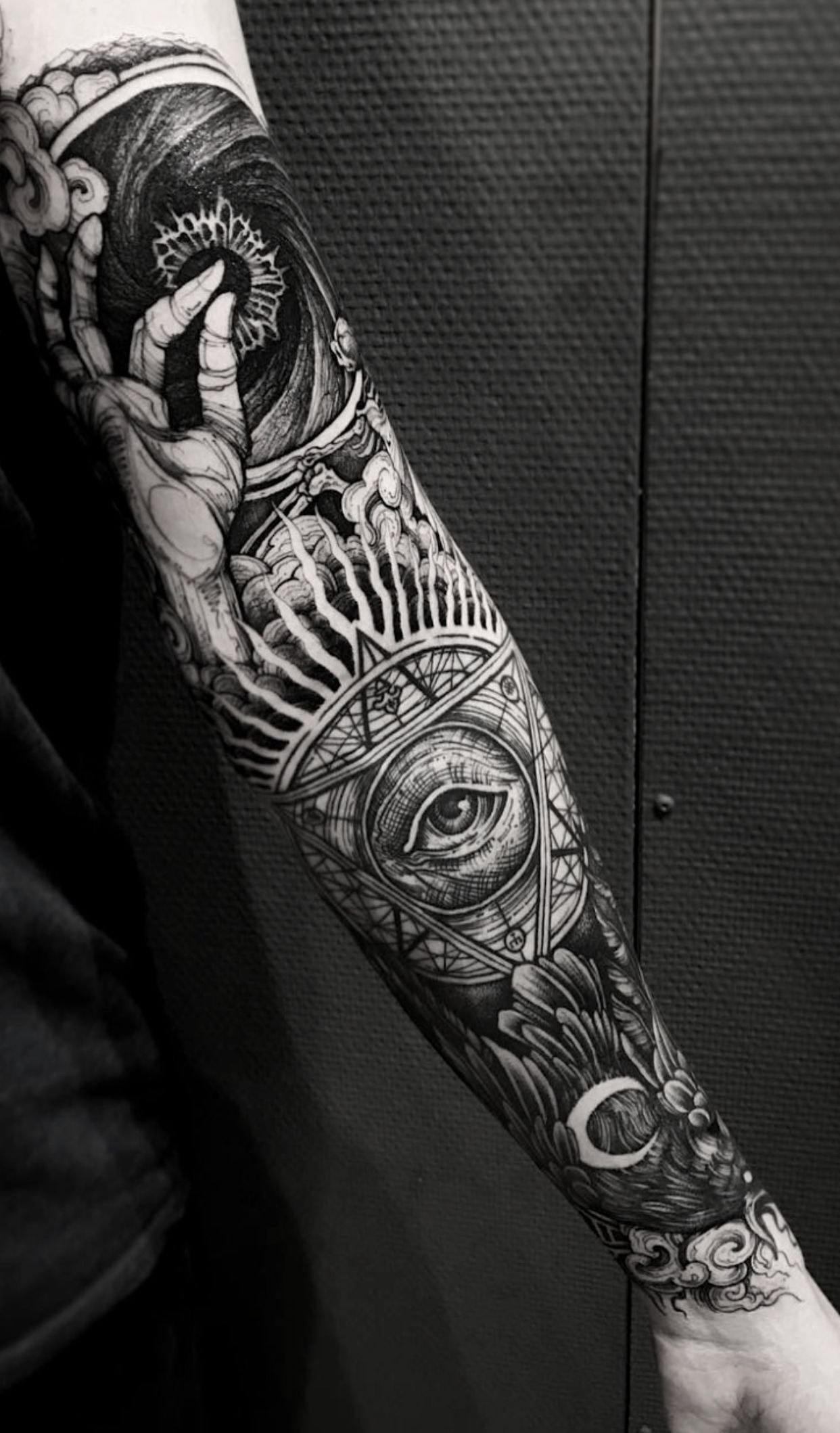Sleeve tattoos have gained much popularity in recent years, and more and more women are opting for this type of tattoo. A sleeve tattoo is a large tattoo that covers a significant portion of the arm, and it can be a great way to make a statement and express your personality and style.
Are you only interested in tattoo designs and want to skip the educational part?
No problem, we got you covered! Click HERE to get inspired.
The Meaning Behind Sleeve Tattoos For Women
Sleeve tattoos for women, like any other type of tattoo, can hold different meanings depending on the individual and their personal experiences. Here are some common interpretations and symbolism associated with sleeve tattoos for women:
Self-expression and Individuality: Sleeve tattoos provide a large canvas for self-expression, allowing women to showcase their unique personality, interests, and artistic tastes. The design elements and imagery chosen for the tattoo can reflect the wearer's passions, values, or significant life events.
Empowerment and Strength: Sleeve tattoos can be symbols of empowerment, resilience, and inner strength for women. They can serve as a visual representation of overcoming challenges, embracing one's identity, or celebrating personal growth.
Beauty and Artistry: Sleeve tattoos are often appreciated for their aesthetic appeal and the artistry involved. Intricate and visually striking designs can be chosen to create a beautiful and visually captivating composition on the arm, showcasing the wearer's appreciation for art and creativity.
Storytelling and Narrative: Sleeve tattoos can be used to tell a personal story or convey a narrative. Each individual tattoo within the sleeve may hold specific significance, representing important people, memories, or transformative experiences in the wearer's life.
Cultural and Symbolic References: Women may choose sleeve tattoos that incorporate symbols or imagery from their cultural background or heritage. These tattoos can be a way to connect with and honor their roots, representing cultural identity, traditions, or spiritual beliefs.
Body Positivity and Self-Acceptance: Sleeve tattoos can serve as a form of body art that promotes body positivity and self-acceptance for women. By embracing and adorning their arms with tattoos, women may challenge societal beauty standards and reclaim their bodies as canvases for self-expression.
What does the sleeve area symbolize for women?
The symbolism of the sleeve area for women can vary depending on cultural, historical, and personal factors. In different contexts, the sleeve area of women's clothing can represent various aspects such as modesty, femininity, social status, cultural identity, or even fashion trends. Here are a few possible interpretations:
Modesty: In some cultures or religious traditions, modesty is highly valued, and clothing with long or covered sleeves can be seen as a symbol of modesty and adherence to cultural or religious norms.
Femininity and Elegance: Sleeves can be designed to enhance the overall feminine appearance of women's clothing. Delicate or flowing sleeves may be associated with grace, elegance, and a softer, more romantic aesthetic.
Social Status: Historically, the length and style of sleeves could be indicators of a person's social status. For example, in certain historical periods, only women of higher social classes could afford to wear clothing with extravagant or elaborate sleeves, while simpler or shorter sleeves were more common among those of lower social standing.
Cultural Identity: Sleeves can be designed in ways that reflect specific cultural identities or traditional attire. Traditional clothing from various regions or ethnic groups may feature distinctive sleeve designs, patterns, or embroidery, serving as a symbol of cultural heritage.
Fashion and Personal Expression: The sleeve area is an important element in fashion, and different sleeve styles can reflect current trends, individual style preferences, and personal expression. Sleeves can be voluminous, fitted, off-the-shoulder, bell-shaped, or have other unique designs, contributing to the overall fashion statement of an outfit.
best sleeve tattoo ideas and their meanings for women
While tattoo preferences and meanings are subjective and can vary from person to person, here are five popular sleeve tattoo ideas for women, along with some common meanings associated with them:
Floral Sleeve tattoos for women
Floral sleeves are highly popular among women, featuring intricate and vibrant flower designs. Flowers often symbolize beauty, femininity, growth, and renewal. Different flowers can carry specific meanings, such as roses representing love and passion, lotus flowers symbolizing spiritual enlightenment, or cherry blossoms signifying the transient nature of life.
Nature-inspired Sleeve tattoos for women
Nature-themed sleeves incorporate elements like trees, animals, landscapes, and natural elements such as mountains, water, or celestial bodies. Nature tattoos can represent a deep connection with the environment, harmony, transformation, and the cycles of life. They may also symbolize personal growth, resilience, and a love for the outdoors.
Geometric Sleeve tattoos for women
Geometric tattoos utilize geometric shapes, patterns, and symmetrical designs to create visually stunning and precise sleeve tattoos. Geometric tattoos often represent balance, harmony, order, and the interconnectedness of various elements. They can also symbolize the balance between the mind, body, and spirit or reflect a person's analytical and structured nature.
Mythological or Fantasy Sleeve tattoos for women
Mythological or fantasy-themed sleeves feature imagery from folklore, mythology, or fantasy realms. These tattoos can represent a love for storytelling, imagination, and a connection to mythical or magical elements. Common symbols include dragons representing strength and wisdom, unicorns symbolizing purity and magic, or phoenixes symbolizing rebirth and resilience.
Symbolic Sleeve tattoos for women
Symbolic sleeves incorporate a collection of meaningful symbols and icons that hold personal significance to the wearer. These tattoos often represent values, beliefs, or milestones in a person's life. Examples of symbolic elements include hearts for love and passion, keys for unlocking new opportunities, compasses for guidance, or meaningful quotes or mantras that inspire and motivate.
Who should get a sleeve tattoo?
Deciding whether or not to get a sleeve tattoo is a personal choice that varies from individual to individual. There is no specific category of people who "should" get a sleeve tattoo, as it ultimately depends on personal preferences, values, and motivations. However, there are a few factors that individuals may consider when contemplating a sleeve tattoo:
Commitment and Personal Style: Sleeve tattoos are typically large and highly visible, covering a significant portion of the arm. They require a significant commitment in terms of time, effort, and finances. It's important to carefully consider if a sleeve tattoo aligns with your personal style and if you are willing to make a long-term commitment to the tattoo.
Meaning and Significance: Sleeve tattoos often carry personal meaning and significance to the wearer. Before getting a sleeve tattoo, it's essential to think about the symbolism and messages you want to convey through the artwork. Ensuring that the design holds personal significance and aligns with your values can make the tattoo even more meaningful.
Tolerance for Pain and Discomfort: Tattooing can be a painful process, especially for large and intricate designs like sleeve tattoos. It's crucial to assess your tolerance for pain and discomfort and decide if you are prepared to endure the tattooing process, which may involve multiple sessions over an extended period.
Professional Considerations: It's worth considering any professional or career implications that a sleeve tattoo may have. In some industries or workplaces, visible tattoos may be discouraged or may require covering up. Evaluate how a sleeve tattoo could potentially impact your current or future professional opportunities and make an informed decision based on your individual circumstances.
Consultation with a Professional Tattoo Artist: Seeking guidance and consultation from a professional tattoo artist is highly recommended. They can provide insights, recommendations, and suggestions based on their expertise and experience. A skilled tattoo artist can help you develop a design that suits your preferences, translates well into a sleeve tattoo, and ensures the best possible outcome.
General Breakdown Of Tattoo Pain Levels On Different Body Parts
Here is a breakdown of the different tattoo pain levels:
- Low: This level of pain is generally described as a mild discomfort or tickling sensation. It is similar to the sensation of getting a light scratch or scrape.
- Moderate: This level of pain is generally described as a moderate discomfort or aching sensation. It is similar to the sensation of getting a deep scratch or scrape or being pinched.
- High: This level of pain is generally described as a strong discomfort or throbbing sensation. It is similar to the sensation of getting a burn or being stung by a bee.
It's important to note that pain tolerance is highly individual and can vary greatly from person to person. Some people may find certain body parts more or less painful than others, and the same body part can be more or less painful for different people. Additionally, the level of pain can be affected by factors such as the size and location of the tattoo, the skill of the tattoo artist, and the individual's own pain threshold.
Tattoo placement pain level chart
Body Part | Pain Level | Explanation |
Forehead | Low | The forehead has few nerve endings, so it is not a particularly painful area. |
Eyebrows | Low | The eyebrows have few nerve endings, so the pain level is relatively low. |
Ear | Low | The ear is a relatively thin and fleshy area, so the pain level is low. |
Nostril | Low | The nostril is a small area with thin skin, so the pain level is low. |
Lip | Low to Moderate | The lip has more nerve endings than some other areas, so it may be slightly more painful. |
Cheek | Low to Moderate | The cheek has a moderate amount of nerve endings, so it may be slightly more painful. |
Moderate | The neck has a moderate amount of nerve endings, so it may be slightly more painful. | |
Moderate to High | The chest has a high concentration of nerve endings, so it can be quite painful. | |
Abdomen | High | The abdomen has a high concentration of nerve endings, so it can be quite painful. |
Back | High | The back has a high concentration of nerve endings, so it can be quite painful. |
Shoulders | High | The shoulders have a high concentration of nerve endings, so they can be quite painful. |
Upper Arms | Moderate to High | The upper arms have a moderate to high concentration of nerve endings, so they can be somewhat painful. |
Elbows | High | The elbows have a high concentration of nerve endings, so they can be quite painful. |
Forearms | Moderate | The forearms have a moderate concentration of nerve endings, so they are not as painful as some other areas. |
Hands | High | The hands have a high concentration of nerve endings, so they can be quite painful. |
Lower Arms | Low to Moderate | The lower arms have a lower concentration of nerve endings, so they are not as painful as some other areas. |
Wrists | Low | The wrists have a low concentration of nerve endings, so they are not very painful. |
Lower Back | High | The lower back has a high concentration of nerve endings, so it can be quite painful. |
Buttocks | High | The buttocks have a high concentration of nerve endings, so they can be quite painful. |
Thighs | High | The thighs have a high concentration of nerve endings, so they can be quite painful. |
Knees | High | The knees have a high concentration of nerve endings, so they can be quite painful. |
Calves | Low to Moderate | The calves have a low to moderate concentration of nerve endings, so they are not as painful as some other areas. |
Ankles | Low | The ankles have a low concentration of nerve endings, so they are not very painful. |
Tattoo aftercare tips
Before getting a tattoo:
Choose a reputable tattoo artist and parlor. Research the artist's portfolio and read reviews from previous clients.
Consult with the artist about the design and placement of the tattoo.
Make sure you are in good health. If you have any medical conditions or are taking any medications that may affect your ability to heal, be sure to let your tattoo artist know.
Consider using a numbing cream to reduce pain during the tattooing process. These creams contain a numbing agent (such as lidocaine) that can be applied to the skin before the tattoo is done. It's important to follow the instructions on the numbing cream and to only use it as directed.
Avoid alcohol, caffeine, and other substances that can thin your blood for at least 24 hours before getting a tattoo.
Eat a healthy meal before your tattoo session to ensure that your blood sugar is stable.
Wear loose, comfortable clothing that allows easy access to the area being tattooed.
After getting a tattoo:
Follow the aftercare instructions provided by your tattoo artist. These may include:
Keeping the tattoo clean and covered with a bandage for the first few hours after getting tattooed.
Washing the tattoo with lukewarm water and a mild soap (such as unscented, antimicrobial soap) and patting it dry with a clean towel.
Applying a thin layer of tattoo ointment or lotion (such as A&D or Aquaphor) to the tattoo and covering it with a clean bandage or wrap.
Repeating this process for the first few days, or until the tattoo has fully scabbed over.
Avoid soaking the tattoo in water for the first week, such as in a bath or pool.
Avoid picking or scratching at the scabs, as this can cause the tattoo to fade or become infected.
Avoid exposure to direct sunlight or tanning beds for at least 2-4 weeks.
If you experience any redness, swelling, or unusual discharge, contact your tattoo artist or a healthcare professional.
Overall, it's important to keep your tattoo clean and moisturized during the healing process to ensure that it heals properly and looks its best. Using a numbing cream can help reduce pain during the tattooing process, but it's important to use it as directed and to follow all aftercare instructions to ensure that your tattoo heals properly.
People Also Ask:
How much does a sleeve tattoo cost?
The cost of a sleeve tattoo will depend on several factors, including the size of the tattoo, the complexity of the design, and the hourly rate of the tattoo artist. A sleeve tattoo can cost anywhere from $500 to $3000.
How long does it take to get a sleeve tattoo?
The time it takes to complete a sleeve tattoo will depend on the size, the design's complexity, and the tattoo artist's skill. On average, completing a sleeve tattoo can take a few days to a few weeks.
Is a sleeve tattoo painful?
Tattooing any body area can be painful, and the sleeve area is no exception. The pain level will vary from person to person and can depend on factors such as your pain tolerance and the location of the tattoo. Minimizing discomfort during the tattooing process is generally recommended, such as taking pain medication or applying numbing cream.
Can you cover up a sleeve tattoo?
It is possible to cover up a sleeve tattoo, but it will depend on the size and complexity of the original tattoo. Covering up a tattoo usually requires a larger and more complex tattoo to be placed over the top of the original tattoo. Working with a skilled tattoo artist with experience covering up tattoos is important to ensure the best results.
Can you get a sleeve tattoo if you have sensitive skin?
If you have sensitive skin, discussing this with your tattoo artist before getting a sleeve tattoo is important. Your tattoo artist can recommend steps to minimize irritation and ensure that the tattooing process is as comfortable as possible.
Watch A Video Of A full sleeve tattoo for women Done By A Pro:
199+ Full sleeve tattoos To Get Inspired From
Final thoughts:
Sleeve tattoos for men can be a powerful way to express oneself and pay tribute to important values and beliefs. Whether you choose a traditional, tribal, or contemporary design, a sleeve tattoo can be a meaningful and long-lasting addition to your body art. It's important to carefully consider whether this is the right decision for you and to choose a reputable and skilled tattoo artist to ensure the best possible results.

